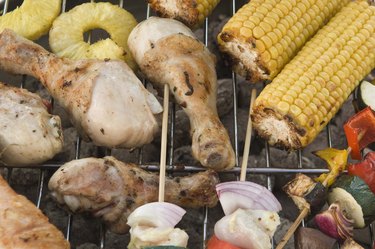
Char-Broil H20 smokers combine low-heat slow cooking with natural smoke seasoning to produce tender, flavorful backyard barbecue. As with all charcoal smokers, natural lump charcoal fires fueled with wet wood chips lead to the best final food product. These smokers are ideal for smoking ribs, chicken, briskets and roasts.
Selecting Charcoal and Wood Chips
Video of the Day
Take some time in selecting the best possible charcoal. Natural lump charcoal--made entirely from hardwood--starts quicker and imparts better flavor than traditional briquettes, which contain chemical additives, binders and fillers. However, briquettes burn for longer periods of time and maintain relatively consistent heat, so a combination of natural lump charcoal and briquettes is ideal for the H20 smoker. Choose hardwood smoking chips based on the type of meat, poultry or fish being smoked. A combination of hickory, oak and fruit woods--including apple and cherry--complement pork and poultry best. The heavier smoke of mesquite forms a nice flavor ensemble for beef, while milder fruit woods and alder work best for fish.
Video of the Day
Pre-Smoking Prep
Pour about five pounds of desired smoking chips in a large plastic bowl or bucket and submerge the chips in water about an hour prior to smoking time. The soaking allows water to penetrate into the chips, which produces more smoke once chips are placed upon glowing lit charcoal.
Remove all grates and pans from the H20 smoker and lay the individual components out in the order removed. Keeping them in order will make the reassembly process easier. Coat the cooking grate with vegetable oil grilling spray or olive oil. Using one of these oils helps keep food from sticking, leaves attractive grilling marks and forms a protective barrier on the grate that will not burn even at high temperatures. Line the charcoal pan and water pan with heavy duty aluminum foil. Regular foil were burn through so use the heaviest grade available. Poke holes in the foil of the charcoal pan to allow for ventilation, then add about seven pounds of natural lump charcoal and a handful of briquettes to the pan. Place four quarts of hot water in the water pan. Adding already hot water means less heat from the fire will go toward heating the water later.
H20 Setup and Smoking
Place the charcoal pan back into the smoker and open the front service door on the H20 unit. Bury an electrical charcoal starter iron in the middle of the coal and plug in the device, allowing it to stay in the charcoal for eight to 10 minutes until the coal begins to smoke and crackle. Using an electric starter rather than charcoal lighter fluid ensures no fuel tastes interfere with food flavor. Unplug and remove the starter and place in a safe location free of children and pets for cooling before storage. Add two handfuls of wet wood chips once coals are glowing or coated with a layer of gray ash.
Wearing protective heat-resistant grilling mitts, place the water pan and grates back in the smoker and add meat to the grates, with larger meat on the grate closest to the fire and smaller meat on the higher grate. Replace the lid and close the service door, adding a handful of wet wood chips to the coals every 30 minutes and about two handfuls of briquette/lump charcoal mix every hour to replenish the heat source. The smoker ideally should be maintained at 200 to 250 degrees inside the chamber throughout the process. Most whole chickens, ribs or roasts prepare within five to eight hours at these temperatures.